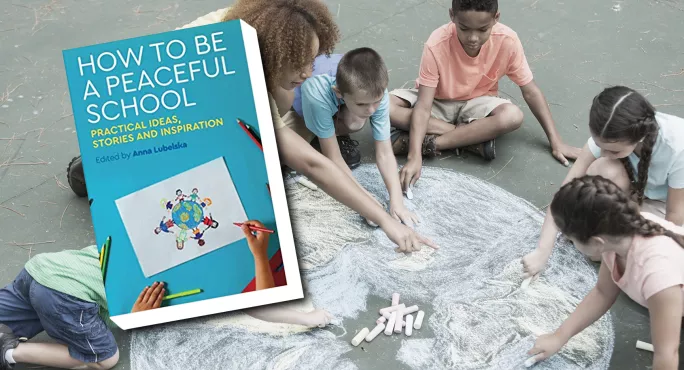- Home
- Book review: How to Be a Peaceful School: Practical ideas, stories and inspiration
Book review: How to Be a Peaceful School: Practical ideas, stories and inspiration

How to Be a Peaceful School: Practical ideas, stories and inspiration
Editor: Anna Lubelska
Publisher: Jessica Kingsley Publishers
Details: 224pp, £14.99, paperback
ISBN: 9781785921568
I suspect that many people looking at the political situation in our country, the divisions caused by Brexit, as well as the schisms, chaos and conflicts that are proliferating across the globe, will agree with the central theme of this book: what the world needs now is peace.
Anna Lubelska, its editor, is the founder of the Peaceful Schools movement - a network supporting a whole-school concept of four interconnected levels of peace:
- Inner peace for the individual pupil/student and members of staff.
- Peaceful relationships and constructive resolution of conflicts.
- Peaceful school ethos and environment (indoors and outdoors).
- Peacemaking within the wider community/world.
Lubelska’s motivation to work for peace has its roots in her own childhood: both her parents were Holocaust survivors and, as she explains in the introduction, her life was affected by the horrific events of the Second World War.
Here, she proposes that the time has come for a radical look at the education we need in the 21st century. And, as the headteacher of an Ashoka Changemaker School (a global network of schools that promote compassion, creativity, collaboration and change-making), I fully agree.
For Lubelska, “the current overstressed, overpoliticised education system produces stressed teachers and children”. It does not need to be like this, she says. “Schools can be peaceful places where teachers and pupils feel supported and valued, and are able to work and able to spend their time cooperating creatively and learning together.”
Across the book’s 13 chapters, the contributing authors cover the four levels of peace that the Peaceful Schools movement has identified. Each one offers a different perspective, with case studies providing practical examples of how a school can be a place of peaceful interactions. The case studies, written by wise, thoughtful teachers, school leaders, as well as educational advisers, are authentic and relatable. They are followed by references to research, as well as suggestions for further reading.
What is encouraging in reading this book is that it is clear that becoming a Peaceful School does not have to be yet another new initiative for schools, one that creates additional work for teachers, making demands on school capacity or requiring new elements to be added to an already full curriculum. Instead, becoming a Peaceful School is a way of framing some of the excellent practice that is already happening in schools up and down the country.
“Peace,” Lubelska says, “is flowing through our schools, in the classrooms, playgrounds and corridors, fuelled by the energy of passionate pioneers.”
Pragmatic approach to peaceful schools
This appreciative and positive book references various peaceful practices with which many schools will be familiar: values education, personal health and social education, philosophy for children, conflict resolution through peaceful means, high-quality religious education, relationship education, mental health and wellbeing, rights-respecting, peaceful playgrounds and outdoor learning.
What I like about this book is that schools can use it to think pragmatically about all the elements that they already have in their own setting that promote prosocial skills and peaceful interaction. They can also use it to find great ideas for approaches that they would like to introduce. Then, using the four steps of the interconnected framework, they can reflect on how they can frame their curriculum, such that it moves beyond narrow metrics to one with a quality, sustainability and ambition towards making the world an even better place.
With inspectorate Ofsted’s latest focus on curriculum, schools will be thinking more about their curriculum, from intention to impact, and this is an excellent and practical book for teachers and headteachers to help them do so.
At the Spinney school, we have been viewing this as concentric circles, the curriculum being everything that encircles a child and the course that should be run - a combination of knowledge, skills and character with relationships at the heart. Our concentric circles chime with the four interconnected levels of peace mentioned in the book, as well as with Valerie Hannon’s four levels of thriving (intrapersonal, interpersonal, societal and global) that she describes in her excellent book Thrive: Schools reinvented for the real challenges we face.
As Neil Hawkes, founder of Values-based Education, says, “The inner curriculum teaches us to be aware and in control of our internal world of thoughts, feelings sensations and emotions, enabling us to respond appropriately to others without hurting them or damaging our own sense of self.”
With all the stresses and pressures in education at present, Anna Lubelska’s book comes at the perfect time for schools to reflect on, and find ideas for, how they can support young people and teachers to be at peace with themselves and within the world.
Rae Snape is headteacher of the Spinney Primary School, Cambridge, and national leader of education of the Kite Teaching School Alliance. She tweets @RaeSnape
You can support us by clicking the title link. We may earn a commission from Amazon on any purchase you make, at no extra cost to you
Keep reading for just £1 per month
You've reached your limit of free articles this month. Subscribe for £1 per month for three months and get:
- Unlimited access to all Tes magazine content
- Exclusive subscriber-only stories
- Award-winning email newsletters


